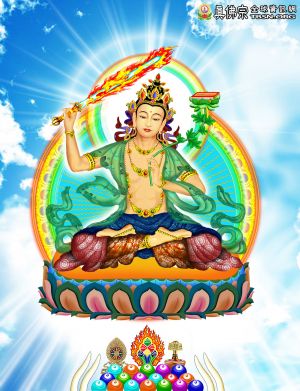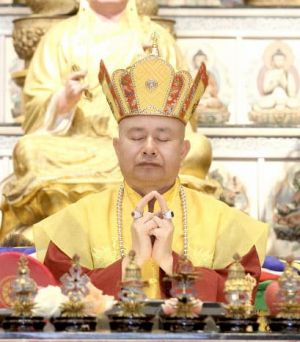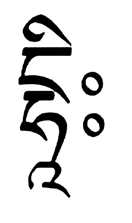Manjushri Bodhisattva-真佛宗
Manjushri Bodhisattva Mudra
Interlace fingers inward. Straighten both middle fingers. Arc the middle fingers with the fingertips touching to form a circle.
Manjushri Bodhisattva Seed Syllable
Manjushri Bodhisattva Dharmalakṣaṇa Brief Introduction
Manjushri Bodhisattva has one head and two arms. His right hand holds a sword while the left hand holds a greenish-blue lotus with a scripture on top of it. He is riding on a lion.
Living Buddha Lian-sheng Sheng-yen Lu Dharma Talk - Manjushri Bodhisattva Background and Magnificence
Manjushri is the Sanskrit name. In Chinese he is called Wen-shu-shi-li, Man-shu-shi-li, or Miao-ji-xiang. In the Mahayana, Manjushri is the bodhisattva most known for wisdom. He and Samantabhadra Bodhisattva are the two main attendants of Shakyamuni Buddha. Of all the bodhisattvas, Manjushri occupies the first seat assisting Shakyamuni, so he is addressed as Dharma Prince Manjushri.
In the Mahabharata, India's most ancient sutra, it is stated that: King Durjaya of the Shambhala Kingdom received oral transmission of the Kalachakra Tantra from an emanation of Shakyamuni in Sri Danyakataka. This lineage of the Kalachakra Tantra was then passed down through 25 generations.
The first king of Shambhala was an emanation of Manjushri called Title King. The second king of Shambhala was White Lotus King. The most well-known works of the White Lotus King are the Immaculate Light Treatise (Kalachakra Tantra essence) and the Auspicious Supreme Vow. White Lotus King was the son of Manjushri Bodhisattva. He was the second king of the Shambhala Pure Land and is one and the same as White Padmakumara.
Manjushri is the principal deity of the Manjushri Hall located in the southwest of the Center Eight Petal Hall in the Womb Realm mandala. In the Diamond Realm mandala he sits at the first north seat among the Sixteen Deities of the present kalpa.
Specifically, Manjushri is in charge of wisdom. His wisdom is number one. His other names are Wen-shu-shi-li, Man-shu-shi-li, Wen-shu-bao-li, Miao-ji-xiang, Miao-yin, Pu-shou, Jing-shou, Miao-de, Ru-shou, Jing-shou, etc. Manjusri Bodhisattva and Samantabhadra Bodhisattva are the attendants standing beside Shakyamuni. As such, Manjusri and Samantabhadra are in charge of the Wisdom Gate and Cognition Gate respectively.
In the past, Manjushri attained Buddhahood, was the teacher of the Seven Buddhas, and was called the Buddha of the Race of Honorable Dragon Kings. His secret name is Auspicious Vajra or Prajna Vajra. In the view of Living Buddha Lian-sheng, Manjushri has a big secret. His ultimate supreme accomplishment is already that of buddha and his power is vast and boundless. He is a teacher of buddhas. According to Buddhist sutras and sastras, Manjushri was the teacher of an infinite number of buddhas and guided numerous practitioners to Buddhahood. Hence, in the Mahayana Sutra of Contemplation of the Mind Ground, he is addressed as Buddha Mother of the Three Times.
In the era of the Buddha's presence on earth, Manjushri's dharma power encompassed the entire Saha world. The Avatamsaka Trinity we often see has Shakyamuni in the middle, Manjusri Bodhisattva on the right, and Samantabhadra on the left. Shakyamuni is well aware of Manjushri's power to save sentient beings at will, his power to transform himself in any way whatsoever, and his infinite supernatural power. Manjushri is thus truly incredible. One can say he is the greatest bodhisattva of all.
In Vajrayana, Manjushri is called the Wisdom Deity. In Mahayana, Manjushri's wisdom is considered the most eminent. In Hinayana, Sariputra's wisdom is considered the greatest. (Living Buddha Lian-sheng Sheng-yen Lu is the emanation body of Sariputra). In Vajrayana, Vajrasattva's wisdom is considered supreme.
Manjushri Bodhisattva occupies the center position of the Three Protectors of Vajrayana. This means he is the primary protector. The Three Protectors of Vajrayana are Manjushri Bodhisattva who symbolizes wisdom, Avalokitesvara Bodhisattva who symbolizes compassion, and Vajrapani Bodhisattva who symbolizes dharma power.
One must take refuge in Avalokitesvara to increase one's bodhicitta and one must take refuge in Manjushri to increase one's wisdom, one's tathagata wisdom, buddha wisdom. There is also Vajrapani Bodhisattva who symbolizes all-encompassing dharma power for accomplishing anything in the world. In Vajrayana these three deities are called the Three Protectors.
Manjushri's image has five hair knots at his crown which symbolize the five wisdoms of Mahavairocana Buddha. He carries a sword in his right hand which symbolizes wisdom and he rides a lion which represents the wrathful nature of wisdom. The fundamental form of Manjushri is Five Syllables and Five Hair Knots, although there are also one-syllable, five-syllable, six-syllable, eight-syllable, one-hair-knot, five-hair-knot, eight-hair-knot, and baby Manjushri. Manjushri's holding a greenish-blue lotus in his left hand symbolizes non-contamination and the severance of all afflictions.
The primary Dharma protector of Living Buddha Lian-sheng is Yamantaka, the greatest Vajra Protector, who emerged from Manjushri entering into Load Yama's samadhi. There is a system that goes like this: Amitabha Buddha - > Manjushri Bodhisattva - > Yamantaka. These three deities are in essence one and the same. Amitabha Buddha is the dharmakaya buddha, Manjushri is the true Dharma buddha, a sambhogakaya tathagata, and Yamantaka is the Wheel of Injunction Vajra. These three deities, Amitabha Buddha, Manjushri and Yamantaka, are mutually interconnected and part of one system.
Manjushri Bodhisattva is the symbol of wisdom in Mahayana Buddhism and there are numerous stories in the sutras of how he used his wisdom to guide and enlighten practitioners. One of the Four Sacred Mountains in China is Mt. Wutai, also known as Qingliang Shan. In the High King Sutra there are the billions of bodhisattvas of precious Qingliang Shan. The billions of bodhisattvas residing at Qingliang Shan were all saved by Manjushri. These billions of bodhisattva are like the emanation bodies of Manjushri residing at Mt. Wutai.
I know that there is a profound affinity between myself and Manjushri. On my first trip to mainland China, I went to Mt. Wutai in Shanxi Province to pay homage to Manjushri Bodhisattva. Of the Buddhist Four Sacred Mountains, the first I visited on my pilgrimage was Mt. Wutai. While I was paying homage at Mt. Wutai, Manjushri emanated as a monk. When I paid homage to deities he did the same. I worshipped from the top of the mountain down to the bottom and he likewise worshipped from the top of the mountain down to the bottom. The two of us worshipped together. He said You have waited a long time for me. Later I gave him money. He said No, not this. I then raised my hand in a certain gesture and he said Yes, that's right, that's it. We smiled and honored each other before departing.
Tsongkhapa, the patriarch of the Gelugpa sect of Tibetan Buddhism, was actually the emanation of Manjushri. As for saving sentient beings, Manjushri not only saves living beings, but also beings in the spiritual world. That is why there is the Manjushri Deliverance Practice, the Manjushri Five Hair Knot Child Deliverance Practice, and the Manjushri Eight Great Child Deliverance Dharma Practice. These are all very important!
It is not the purpose of the Manjushri Deliverance Practice of Vajrayana Karmic Practices to encourage killing beings. Instead, it is to take advantage of Manjushri's dharma power to deliver beings. This is a special Manjushri Deliverance Practice. It greatly benefits and relieves restaurant workers. It is a supreme secret.
Living Buddha Lian-sheng regards the Youth Manjushri Wheel Mantra Practice proclaimed by Buddha at Heaven of Pure Abode as the fundamental one word mantra of Manjushri. This one word mantra is Om。bu-lin。 or Om。ci-lin。 It is also the Completion Mantra. Whoever chants this mantra and practices the visualization of the three major bodhisattvas (Manjushri, Avalokitesvara and Samantabhadra,) will receive the support and protection of Manjushri and all other bodhisattvas. In addition, Manjushri's five attendants and eight youths will also support and protect the practitioners.
Someone asked me, What is om, bu-lin?
I answered, This mantra is the One-word Heart Mantra in the Manjushri Sadhana. It is also the Big Wheel One-word Mantra and pronounced bu-lin.
I was asked again, Why does om, bu-lin have such great merit?I replied, Because om, bu-lin is the heart of Manjushri. It is the utmost mantra of all buddhas and bodhisattvas.
Source
[[1]]


